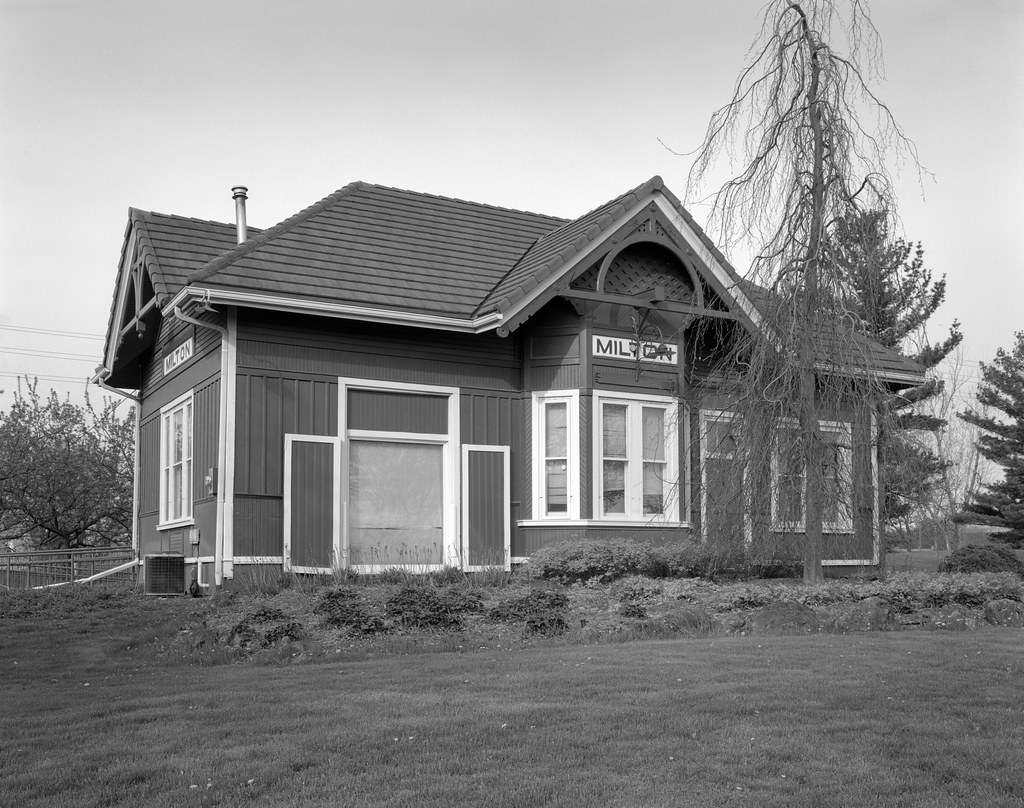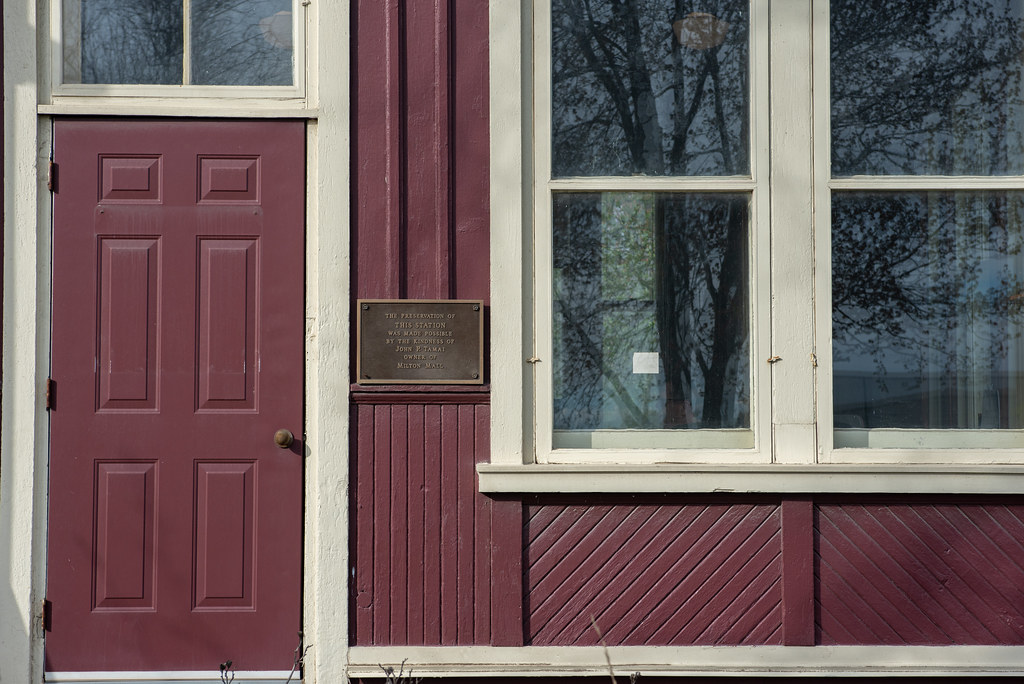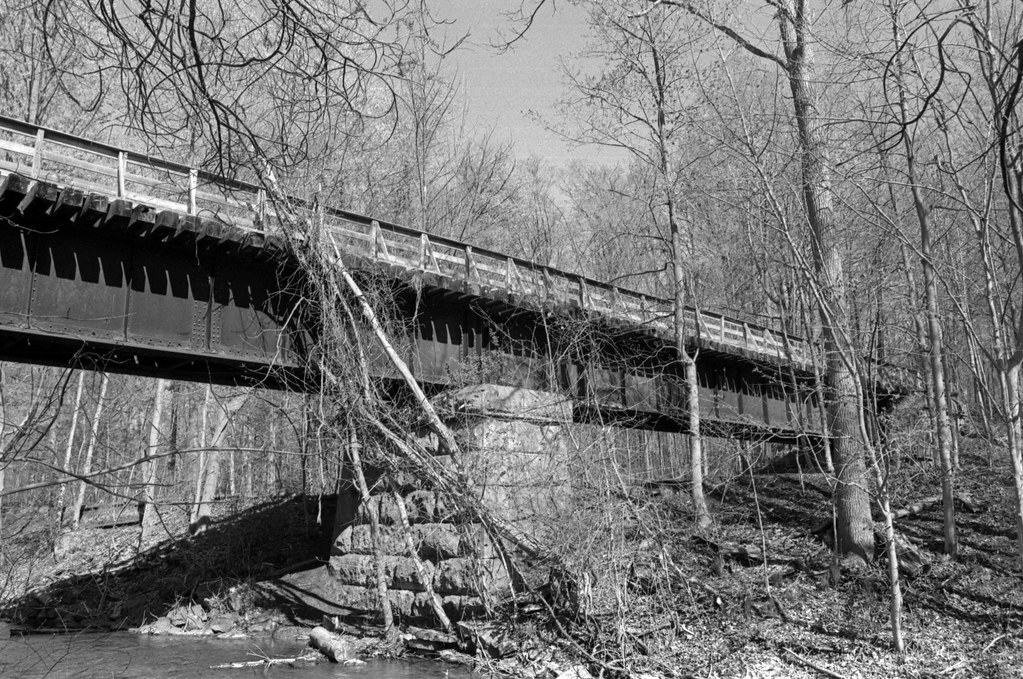Most people would drive past a small red building sitting along Highway 25 south of the Canadian National train line running over the roadway heading into downtown from Highway 401. The red building has the appearance of a railroad station. Still, the rail line is sitting high above, and there is no way for the station even to serve the line when Canadian National operated passenger services. The building is Milton’s third train station. It is not so far from its original location located on the outskirts of the downtown next to Milton’s claim to fame, the P.L. Robertson factory, maker of the Robertson screw.

Graflex Crown Graphic – Fuji Fujinon-W 1:5.6/125 – Ilford HP5+ @ ASA-200 – Pyrocat-HD (1+1+100) 9:00 @ 20C
Founded in 1820, the town of Milton missed the first railroad boom in Ontario. Despite being named (over Oakville) as the seat of Halton County in 1857, the railroad had no reason to pass through the rural backwater town. It wasn’t until the second boom in the post-confederation decades that the railroad arrived in Milton. The Hamilton & North-Western Railway had been chartered in 1874 to construct a line running from Hamilton’s industrial sectors to Collingwood as a direct competitor to Northern Railway of Canada, formerly Ontario, Simcoe & Huron. Like many railways, Hamilton & North-Western suffered financial troubles early on, and construction ran in fits and spurts, but in 1876 had passed through Burlington and arrived in Milton. The line running right through the downtown, crossing the Sixteen Mile Creek and the Mill Pond via a simple rail bridge before pushing through reaching Barrie in 1877. At Milton, the Credit Valley Railway intersected the Hamilton & North-Western line, a bit west of Martin Street, and a watch town had to be constructed to ensure trains would not collide in the middle of town. Starting in 1879, Hamilton & North-Western began constructing simple shed type stations, including one in Milton. The Milton station sat north of Victoria and Bronte Streets intersection, close to but a bit outside of the downtown. How the station originally looked remains a mystery as there are no known photographs in its original form. But it probably had a single waiting room, station master’s office and baggage room. By June 1879, Hamilton & North-Western, along with the Northern Railway of Canada, merged into a single corporation, North & North-Western Railway. The merger remained an unhappy one, but operations continued. North & North-Western remained a popular freight line but offered little to passengers. At the same time, Credit Valley had a link between Toronto and St. Thomas, with a connection there to the Canadian Southern Railway provided more popularity for passengers. But as North & North-Western pushed further north towards the promised Canadian Pacific line at Callendar, they exploited the popularity of the growing cottage industry in Muskoka. By 1886 the line hit Callendar, and two years later, exploiting the continued disagreements between managers in the operator, Grand Trunk Railway purchased the whole network.

Nikon D750 – AF-S Nikkor 28-70mm 1:2.8D
Nikon D750 – AF-S Nikkor 28-70mm 1:2.8D
While Grand Trunk continued to use the old Hamilton & North-Western station, the efforts of Charles Hayes in 1896 saw a series of modernizations completed on the network. Hayes did eliminate several duplications on the network and removed references to several older lines that continued to operate under their original liveries, including North & North-Western. Starting in 1900, they also began constructing new stations to replace several older ones. Despite being a low traffic line, Milton would receive a new station in 1903. A simple station with a small footprint. Constructed in the Queen Anne Revival style and board and batten construction. The new station was painted in the grey, green, and mauve colour scheme. Internally the station had a single general waiting room, station master office, which acts as a ticket office and telegrapher’s bay which jutted out from the station. The rest of the station was taken up by the baggage and express room. The original station was left in place and renovated into a freight shed. Milton remained primarily an agricultural community but the increase in manufacturing, namely the opening of the P.L. Robertson plant, made heavy use of the freight options for the railroad. Grand Trunk would also construct a new bridge and update the old rails at the same time. Freight remained king; passenger service by 1904 had been reduced to two trains daily, one heading towards Barrie the other towards Hamilton. Canadian National took over operations in 1923 after Grand Trunk went bankrupt and was absorbed into the new railway operator. They maintained the status quo at Milton. In the 1950s, Canadian National painted over the Grand Trunk colours with the standard railroad red that proved popular across all operators. The low traffic on the line saw the introduction of the early Rail Diesel Cars (RDC) to run mixed passenger and freight cars on the Hamilton to Barrie Run. But as passenger traffic continued to drop, passenger services from the Milton station ceased in 1961. This was preceded by Canadian National intended to move their line through Milton outside the downtown; the town council approved the change. The change proved controversial it did result in a much quieter downtown. The Milton bypass opened to rail traffic in 1965. A majority of the downtown line was torn up with only a small section left intact and turned over to Canadian Pacific, who connected it to their line running through town. Oddly enough, if you look at a satellite view of the modern town, you can still see where the original line ran through the downtown.

Nikon D750 – AF-S Nikkor 28-70mm 1:2.8D
Nikon F5 – AF-S Nikkor 28-70mm 1:2.8D – Eastman Double-X 5222 @ ASA-200 – FPP D96 (Stock) 6:00 @ 20C
The original Hamilton & North-Western Station was torn down in 1971; rather than let the Grand Trunk Station meet the same fate, the town purchased the station from Canadian National and moved it out of downtown to Unity Park. Restoration costs were mainly covered by Lois and Henry Nadlin, with the heavy work being completed by inmates from the Mimico Reformatory. Rather than restore the station to Grand Trunk colours, they went with the mid-century railroad red colour. The station opened as the Milton tourist information centre in 1975. Later that year, a narrow-gauge steam locomotive was put on display. Locomotive 4103 had never served in Milton or on any major railroad. Rather the 1930 constructed Vulcan locomotive had served in quarries in the United States and Canada. After spending time at the Ontario Science Centre, it was restored in Oakville and put on display. After years of neglect, the locomotive was most likely removed in the early 2000s and moved to Iowa and restored for service on a hobby railroad in Oregon. The station itself remains today and is now home to the Milton chapter of the United Way. The park has changed names since then and is now named Chris Hadfield Park. Milton’s other surviving railroad station, the original 1879 Credit Valley Station survives as a private home on Commercial Street having been moved there after being replaced by a Maxwell style station by Canadian Pacific in 1914. The Canadian Pacific Station ended up being demolished in the late 1960s. On another interesting note, a GTR station was moved to Milton from Bronte when GO Transit opened the Milton line, it has also been demolished.

Nikon D750 – AF Nikkor 35mm 1:2D